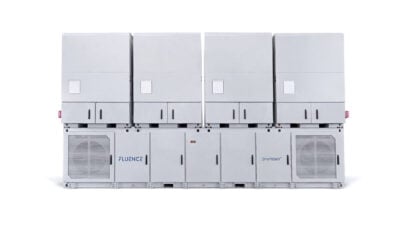Batteries are considered the second most matured technology for energy storage, after pumped hydro, in the IRENA report. Image: Younicos.
The cost of lithium-ion batteries for energy storage declined 65% in five years between 2010 and 2015, while battery storage’s use for electricity could hit 250GW by 2030, from just 1GW today, according to the International Renewable Energy Agency (IRENA).
“REThinking Energy 2017: Accelerating the global energy transformation” is the latest ‘flagship’ report from the agency, analysing policies, technologies and technical innovations, as well as deployment figures and markers for moving forward to decarbonise and decentralise world energy networks.
Findings include a statistic from German grid operator 50Hz that variable renewable energy penetration on its network could reach 70% without significant investment in energy storage technology. However, the report is unequivocal in stating that electricity storage as a source of system flexibility will become ever-more important as variable renewable energy rises as a proportion of overall energy mixes throughout the world.
Storage has a role to play in both existing grids and in providing energy access to those that currently have none, with the replacement of diesel use in island and remote settings expected to be a particular point of focus. Within existing grids storage will exist alongside a suite of new solutions including better demand side response and distributed generation to match load to supply, the report explains.
Try Premium for just $1
- Full premium access for the first month at only $1
- Converts to an annual rate after 30 days unless cancelled
- Cancel anytime during the trial period
Premium Benefits
- Expert industry analysis and interviews
- Digital access to PV Tech Power journal
- Exclusive event discounts
Or get the full Premium subscription right away
Or continue reading this article for free
Not just batteries
Batteries are considered the second most mature technology for energy storage by the IRENA report’s authors, after pumped hydro storage. While IRENA predicts that pumped storage facilities will also increase – from 150GW in 2014 to as much as 325GW by 2030, there is also an understanding that with high capex required and suitable geographic locations harder to find, these installations may not be used as diversely or as nimbly constructed as battery storage facilities.
The report’s section on technology innovations highlights the five different broad definitions of energy storage, including batteries and runs through the advantages and disadvantages of each: mechanical (including pumped storage and flywheels), electrochemical (including lithium-ion and other batteries such as lead-acid, sodium sulphur and flow batteries), thermal (including molten salt, ice and phase change materials), electrical (supercapacitors and superconducting magnetic energy storage) and chemical i.e. hydrogen (including fuel cells and power-to-gas).
Battery storage market values in leading countries. Image: IRENA from GlobalData.
Sector coupling
High on the agenda at many technical and market conferences, but perhaps not yet on the average consumer’s radar, is the need for increased sector coupling. In other words, in addition to standalone electricity generation, the heating and cooling and transport sectors need to adapt to an increased electrification and therefore increased integration of renewable energy. This could include the use of electric vehicle (EV) batteries as grid assets, IRENA’s report said. ‘Smarter’ energy networks would share data and resources, allowing for optimal use of these and other assets.
Barriers, challenges and how they can be overcome
The report acknowledges that “several barriers” exist to battery storage’s adoption as a “mainstream option in the power sector” but also notes “promising signs of progress”. So far, regulatory treatment has been uncertain, there are limits to valuing storage in a monetary sense in many markets, and utilities are yet to accept them en masse, to name but a few, while stakeholders are still relatively unfamiliar with the benefits they can confer to balance grids and add reliability to renewable energy-driven networks.
In addition, cost remains the most significant obstacle, as the report highlights, but stresses that, in part due to adoption by the transportation industry, the costs of advanced batteries are rapidly falling. In 2015, lithium-ion battery prices fell to US$350 per kWh, a 65% decline since 2010 and could fall to below US$100 per kWh within the next decade – quoted from a McKinsey & Company and Bloomberg New Energy Finance report.
“Battery storage could become economically viable to support self-consumption of rooftop solar PV in locations with high residential electricity prices,” the report continues.
Better quantification of the other benefits of battery storage, such as its ability to balance the grid and provide backup power would further support the technology.
As the report’s foreword by IRENA director-general Adnan Z Amin points out, the human race may need to “nurture and grow the global energy transformation at an unprecedented scale and pace” to “ward off a climate catastrophe” and squarely puts energy storage, alongside many other technologies and options as part of that transformation.
The IRENA report can be viewed here.





